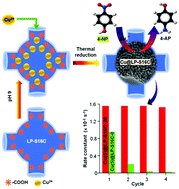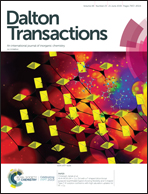Confinement of Cu nanoparticles in the nanocages of large pore SBA-16 functionalized with carboxylic acid: enhanced activity and improved durability for 4-nitrophenol reduction†
Abstract
Carboxylic acid (–COOH) functionalized large pore mesoporous silica SBA-16 is prepared and utilized as the support to synthesize Cu nanoparticles (NPs). The interaction between the –COOH groups in the support and the metal precursors effectively controls the dispersion and size of the Cu NPs. The Cu NP encapsulated large pore SBA-16 is used as a catalyst for the reduction of 4-nitrophenol (4-NP) to 4-aminophenol (4-AP). The catalyst shows an excellent reaction rate of 1.55 × 10−2 s−1 and an outstanding activity of 950 s−1 g−1. The prominent catalytic activity can be attributed to the nanoscale dimension of the Cu NPs (ca. 5 nm) and their homogeneous distribution, and the 3D pore architecture of the support that allows easy transportation of the reactants. The cage-type mesopores of the support SBA-16 also effectively prevent aggregation and leaching of Cu NPs, and thus exhibit similar catalytic activity for several cycles, indicative of its superb durability.



 Please wait while we load your content...
Please wait while we load your content...